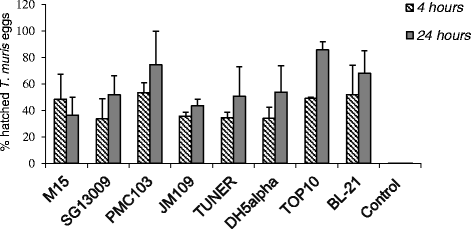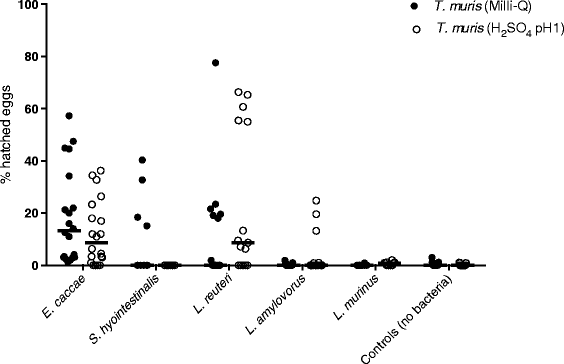Bacteria-induced egg hatching differs for Trichuris muris and Trichuris suis
- PMID: 26174801
- PMCID: PMC4501204
- DOI: 10.1186/s13071-015-0986-z
Bacteria-induced egg hatching differs for Trichuris muris and Trichuris suis
Abstract
Background: Eggs of the porcine whipworm Trichuris suis are currently explored in human clinical trials as a treatment of immune-mediated diseases. In this context, only the infective, embryonated eggs, constitute the Active Pharmaceutical Ingredient (API). The rodent whipworm, Trichuris muris is commonly used as a laboratory model to study Trichuris biology. The embryonated eggs (containing a fully developed larva) are biologically active and will invade the large intestinal mucosa of the host. This study aims to assess the in vitro hatching of T. muris and T. suis eggs in various bacterial cultures as a measure for their biological activity.
Methods: Eggs of T. muris and T. suis were incubated with Escherichia coli strain (BL-21) at three concentrations in a slightly modified in vitro egg hatching assay previously developed for T. muris. Additionally, E. coli strains (M15, SG13009, PMC103, JM109, TUNER, DH5alpha, TOP10) and five Gram-positive bacteria (Enterococcus caccae, Streptococcus hyointestinalis, Lactobacillus amylovorus, L. murinus, and L. reuteri) were tested as a hatching stimulus for T. muris and T. suis eggs.
Results: Whereas T. muris eggs hatched, T. suis did not, even when exposed to different concentrations and strains of E. coli after 4 and 24-hour incubation. When incubated with Gram-positive bacteria, only T. muris eggs showed noticeable hatching after 20 h, although with high variability.
Conclusions: The observed difference in hatching of T. muris and T. suis eggs incubated with selected bacteria, indicate significant biological differences which may reflect specific adaptation to different host-specific gut microbiota.
Figures




Similar articles
-
Hatching of whipworm eggs induced by bacterial contact is serine-protease dependent.PLoS Pathog. 2025 Jan 27;21(1):e1012502. doi: 10.1371/journal.ppat.1012502. eCollection 2025 Jan. PLoS Pathog. 2025. PMID: 39869639 Free PMC article.
-
Bacteria-induced hatching of Trichuris muris eggs occurs without direct contact between eggs and bacteria.Parasitol Res. 2016 Jan;115(1):437-40. doi: 10.1007/s00436-015-4795-2. Epub 2015 Oct 20. Parasitol Res. 2016. PMID: 26481492
-
Evidence for bacteria-independent hatching of Trichuris muris eggs.Parasitol Res. 2013 Apr;112(4):1537-42. doi: 10.1007/s00436-013-3300-z. Epub 2013 Jan 29. Parasitol Res. 2013. PMID: 23358735
-
Whipworm secretions and their roles in host-parasite interactions.Parasit Vectors. 2022 Sep 29;15(1):348. doi: 10.1186/s13071-022-05483-5. Parasit Vectors. 2022. PMID: 36175934 Free PMC article. Review.
-
Trichuris suis ova in inflammatory bowel disease.Dig Dis. 2013;31(3-4):391-5. doi: 10.1159/000354708. Epub 2013 Nov 14. Dig Dis. 2013. PMID: 24246995 Review.
Cited by
-
Reciprocal Interactions between Nematodes and Their Microbial Environments.Front Cell Infect Microbiol. 2017 Apr 27;7:144. doi: 10.3389/fcimb.2017.00144. eCollection 2017. Front Cell Infect Microbiol. 2017. PMID: 28497029 Free PMC article. Review.
-
Hatching of whipworm eggs induced by bacterial contact is serine-protease dependent.PLoS Pathog. 2025 Jan 27;21(1):e1012502. doi: 10.1371/journal.ppat.1012502. eCollection 2025 Jan. PLoS Pathog. 2025. PMID: 39869639 Free PMC article.
-
Parasites modulate the gut-microbiome in insects: A proof-of-concept study.PLoS One. 2020 Jan 14;15(1):e0227561. doi: 10.1371/journal.pone.0227561. eCollection 2020. PLoS One. 2020. PMID: 31935259 Free PMC article.
-
Canine and Feline Parasitology: Analogies, Differences, and Relevance for Human Health.Clin Microbiol Rev. 2021 Dec 15;34(4):e0026620. doi: 10.1128/CMR.00266-20. Epub 2021 Aug 11. Clin Microbiol Rev. 2021. PMID: 34378954 Free PMC article. Review.
-
Behavioral Cooperation or Conflict of Human Intestinal Roundworms and Microbiomes: A Bio-Activity Perspective.Cells. 2025 Apr 7;14(7):556. doi: 10.3390/cells14070556. Cells. 2025. PMID: 40214509 Free PMC article. Review.
References
Publication types
MeSH terms
Grants and funding
LinkOut - more resources
Full Text Sources
Other Literature Sources

